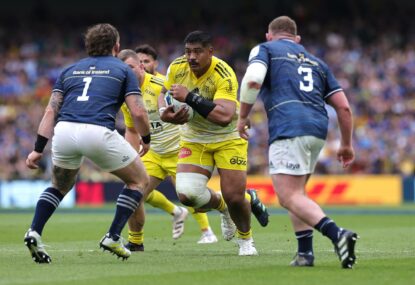“But he’s not wearing anything!”, cried a two-year-old, in the famous Hans Christien Andersen tale.
Whereas the majority of the emperor’s subordinates, in fear of persecution and resounding pluralistic ignorance, turned a blind eye to the blindingly obvious, it took a child’s unbiased conscience to call it as he saw it.
Perhaps apt descriptions of England’s Rugby World Cup debacle, and the subsequent hiring of (some would argue two years of age) Eddie Jones.
All the talk prior to the 2015 World Cup was of the fabled ‘Pool of Death’. Not in question was England’s passage through to the quarter-finals, rather who of Australia or Wales would fail to make it through.
We all know how all the permutations and predictions panned out. England had worked hard the previous four years to turn around a toxic culture that was thought to be the missing piece in the puzzle en route to home ground glory.
They also envisioned an English model of the All Blacks. They showed glimpses and progress, but when it was time to put their chips on the table, they reverted to type, acknowledging that in the biggest games in previous World Cups attacking rugby was a death trap. Thus the inclusion of Owen Farrell and Sam Burgess.
They failed.
Jones’ arrival was met with trepidation by some, cheers from others and snarls from most. An Aussie coaching the English? Wait a minute, weren’t they not our colony not too long ago?
Nonetheless, it was widely, and correctly, heralded as a smart choice. Jones came in and immediately announced his focus on set-piece strength, heads up attacking rugby, and defensive dominance. So let’s have a look at England’s gameplay in their first two games against Scotland and Italy.
Set piece
Under Graham Rowntree, England would pivot after the ‘set’ call, angling on the loosehead’s side to penetrate the opposition scrum.
This has changed under Jones. He has instructed England to drive straight and tight as a pack. One only has to see the difference between shuffling of feet under Rowntree versus the steadiness of feet position under Jones.
It is also noticeable that England want to exert dominance scrum time, leaving the ball in the scrum for a longer period of time even once available. Their scum has been solid to good against Scotland and Italy, with dominance coming in patches, mostly in the latter stages of both games, notwithstanding occasional mishaps on their part and the opposition’s.
Their lineout was superb against Scotland, while poor against Italy. Their go-to set-up involves a seven-man lineout, looking to mostly maul or using the second jumper to set up Billy Vunipola in midfield. They also used four-man lineout variations, and full-man lineouts when close to the opposition try line.
Their mauling has been poor to say the least. They have been penalised for detachment, coming in from the side, and more often than not they fail to gain momentum.
However, their lineout will only get stronger under Steve Borthwick (just have a look at Japan’s lineout play, or with Saracens/England when he was playing) in due time, once familiarity with new systems becomes second nature.
Attacking rugby
Focusing first on their kicking game, Jones (or maybe Jonny Wilkinson) has introduced a new version of the Gerry Owen off fly-half. Multiple times in both games, almost exclusively when play flows right to left, George Ford has looked to put an up-and-under after a midfield phase set up.
The idea being the opposition winger is forced to come shallower than usual in light of a potential attack down their flank, leaving the fullback isolated and prone to counter rucking when well executed.
Perhaps this is also indicative with their pending tour to Austrlia, where Michael Cheika likes to put his flyhalf in the back three off defensive lineouts. The idea is sound, yet Ford’s accuracy has been left wanting, albeit turnover success has been high when the kick is good. Just have a look at Jonathan Joseph’s first try against Italy.
It is also noticeable that either Chris Robshaw or James Haskell has followed closely behind the chasing wing on all box-kicks and Owens. There is much improvement to be made on their kicking, particularly as with the current trend in rugby today, kicks are now seen as more attacking than defensive strategies. They not only disallow counter attacks but can also lead to regaining possession.
England’s phase play attack has been stuttering to say the least. Off the set piece, the look to either break the advantage line of first play with a direct runner such as Billy Vunipola, Jack Nowell or Owen Farrell, or use second man plays or loops through Ford.
They have also varied this option with their ball carriers being used as playmakers. But their main set-up seems to have their strongest ball carriers in midfield with their forwards staying within the two 15-metre channels, with Ford and Farrell looking to attack.
Mike Brown has also come in as a playmaker on the blindside, however this is not a strength of his game. Backs moving off phase play has been a rarity, leaving them short of ideas once the forwards are unable to break the advantage line. All this has to be taken with a pinch of salt, considering the new structures and short time Jones has had with his squad.
Back play leaves a lot to be desired, especially off the set piece, and the combinations do not seem to fit with Jones’ gameplay vision for his backs. What is also noticeable is how on attack the decision-making at the breakdown has been left wanting.
Many a time, the first man in the ruck has come late. We may be talking in milliseconds, but in Test rugby that is the difference between winning and losing, more so with the amount of breakdowns involved in today’s game.
This will only improve, again once systems become second nature. Take note, however, of the abovementioned comment on the lack of combinations in the backs, a huge area of concern during the Stuart Lancaster years. Once the combinations are set, England’s attack will run smoother with the breakdown following suit.
Defence
The most outstanding aspect of England’s play so far. Under Paul Gustard, England’s defence has focused on being connected, and accompanied by line speed.
They are not concerned with space when their numbers are short, nor do they adopt a drift shape when numerically outnumbered. Instead they focus man on, and use their back three to scramble if necessary.
So far it has worked, taking into account the low standard of passing from Scotland and Italy. England’s tackling in the forwards has been strong, led by Haskell, but their centres in Farrell and Joseph have much work to do.
Bravery is one thing, technique is another. Too many times both were caught square-on in tackling, leaving the head at the carrier’s mercy, and consequentially were bumped off easily. Nowell has been superb for the backs in this regard.
Breakdown wise England look to be making better decisions around ruck time. They have chosen wisely when to engage, and when to fan out. These days, all players must have the ability to disrupt the ruck and also pilfer the ball. But their lack of a natural openside in the southern hemisphere mould is preventing their defence from moving to the next level.
A case in point is in the third minute of the Italy game, when England turned over possession in a lineout with Italy spreading the ball down their backline. Once tackled and isolated, the first man in was Haskell, whose attempt to pilfer can only be described as meek. He was easily cleaned out by a back.
Turnover possession is sacrosanct to opening a Pandora’s box of tries for world-class teams. Jones will have to find his man as soon as possible, as relying on Vunipola and Dan Cole for turnovers is not a viable scenario and will leave England well stunted in the turnover trie statistics.
Narrow minded you may say, well have a look at David Pocock’s influence when he is playing and when he is not. Defence is the easiest aspect in regard to systems to coach, so it is no surprise this has proved England’s strongest point thus far.
Jones may very well be satisfied with two wins from two games thus far, but he is also well aware of the winding road ahead. He has said as much, publicly stating the fruits of labour will only be borne in the third to fourth years of his reign.
Sterner tests await, in the form of Ireland next and also France. His first true test will be against Wales, and it is then can we truly measure the impact and progression of this England side.
One must also note the limits on the systems he has introduced, as all great coaches do when overhauling and revamping, slowing entrenching detail and polish the more time he spends as head coach.
Similar to the two-year-old, Jones will be unafraid to call it as he sees it and will make no apologies. But when, not a question of if, this emperor (England) finds its clothes there will be no ambiguity.
Note: England to beat Ireland within 10 points.




































































































